Grain Yield and Nitrogen Use Efficiency of Hybrid Rice in Response to High Plant Density and Nitrogen Rate
Jiang Peng , Xu Fu-xian *, Zhang Lin Zhou Xing-bing Xiong Hong , Liu Mao Zhu Yong-chuan and Guo Xiao-yi
1 Rice and Sorghum Research Institute, Sichuan Academy of Agricultural Sciences/Key Laboratory of Southwest Rice Biology and Genetic Breeding,Ministry of Agriculture, Deyang 618000, China;
2 Crop Ecophysiology and Cultivation Key Laboratory of Sichuan Province, Wenjiang 611130, Sichuan, China
Abstract: Increased plant density with low N rate was a recommended strategy to increase grain yield and N use efficiency (NUE);however, grain yield, NUE and the total N uptake (TNU) responses of hybrid rice to this strategy at different yield levels (medium yielding site (MYS) Luzhou City and high yielding site (HYS) Deyang City had not been described. Field experiments with hybrid rice Rongyou1015 were conducted to study the effects of two plant densities. High plant density (HD), low plant density ( LD) and four N rates (without N, N0; a recommended N rate of 195 kg • hm-2, NCK; a 23% reduction in N rate, N-23%; a 46% reduction in N rate,N-46%) on yield attributes, grain yield, TNU and NUE of hybrid rice were studied under different yield levels in 2016-2017. The results showed that the grain yield and NUE of hybrid rice in response to plant density and N rate varied with yield levels. For MYS, reducing N rate by 46% result in significantly lower grain yield at LD treatment; whereas at HD treatment the grain yield of hybrid rice under N-46% and NCK were equal. For HYS, reducing N rate by 46% result in significantly lower grain yield regardless of low plant density and high plant density; however, a reduction in N rate by 23% increased grain yield, AEN by 36%, PFPN by 31% and REN by 11% over NCK at HD treatment. Higher grain yield of hybrid rice under the combination of HD with low N rate was attributable to improvement in spikelets per panicle and harvest index. The results suggested that high plant density with low N rate might be an effective approach to improve grain yield and NUE in rice production, but reduction in N application rate was determined, according to yield levels.
Key words: plant density, hybrid rice, nitrogen use efficiency, grain yield, yield level, nitrogen rate
Introduction
Rice is the main staple food for more than 65% of the population of China. Grain yield significant decline has been found in the main rice grain-production areas of China in the past decade (Fanet al., 2009), but China has to produce more than 1.0% rice per year to meet the demand of consumers in the next decade(Rayet al., 2013). In China, a large number of farmers transplanted rice at extremely wide spacing planting for saving labors and seed cost that may be the one of the main constraints to increase grain yield (Penget al., 2009); and they think that lower tiller number caused by extremely wide spacing planting can be compensated by applying external nitrogen. Although panicles per hill are higher under sparse planting than that under dense planting, there are significantly lower panicles per unit land area under sparse planting than that under dense planting (Liet al., 2006). Zhaoet al.(2012) reported that maximum tiller number per unit land area is extremely significantly affected by plant density, and the trend of maximum tiller number per unit land area increases first, and then decreases with increasing plant density. Moreover, Huanget al. (2011a) had been demonstrated that grain yield is significantly positively correlated with panicle number per unit land area in farmers' field in Hunan Province.Tillering is one of the most important agronomic traits that strongly affect panicle number per unit land area(Moldenhauer and Gibbons, 2003). Previous studies showed that panicle number per unit land area is positively correlated with maximum tiller number per unit land area, but not with panicle-bearing tiller rate (Huanget al., 2011b). Plant density is one of the key factors that determine the tiller production in rice. Dense planting generally leads to increased tiller number per unit land area that results in high panicle number per unit land area and grain yield.Recently, a series of studies have been demonstrated that increasing plant density is an effective approach to achieve high grain yield in southern China (Liet al.,2011; Wuet al., 2013; Xieet al., 2016; Jianget al.,2017).
In China, the high-yielding hybrid rice cultivar,which are developed by combining an ideotype approach with the use of intersubspecific heterosis(Yuan, 2001), has strongly tillering capacity, heavy(5 g per panicle) panicles and high aboveground biomass at maturity. As a consequently, wide spacing planting has been widely conducted to alleviate the conflict between an individual and rice population(Ma and Tao, 1997). Under wide spacing planting,high or excessively N fertilizer rate is usually applied to enhance tillering that leads to increased panicle number per unit land area for high grain yield (Zhu and Jin, 2013). Although high rate of N application usually increases grain yield, only 20%-30% of N is taken up by rice plants and a very large proportion of N loss to the environment (Penget al., 2009), and results in lower N use efficiency. Thus, reducing N application rate can significantly increase N use efficiency (Penget al., 2006). However, if only reduction in N fertilizer rate without increasing plant density may lead to deceased grain yield that results from low panicle number per unit land area.
Recently, increasing plant density is a recommended strategy to reduce external N input in double-season or single-season rice production (Zhuet al., 2016;Huanget al., 2017). These results indicated that the combination of high plant density with low N rate can achieve high grain yield. However, the studies just are conducted in one yield level (a location);very little attention has been paid to the effect of optimal combination of plant density with N rate on grain yield, yield components, biomass production,the total N uptake and N use efficiency of hybrid rice at different yield levels. Therefore, a two-year experiment was conducted at one MYS and one HYS to detect the combined effect of plant density and N rate on grain yield, yield components, biomass production, the total N uptake and N use efficiency of hybrid rice variety. The objectives of this study were to determine yield performance and N use efficiency of hybrid rice cultivars under different plant densities and N rates and to determine the feasible approach for rice production with high grain yield and high N use efficiency in different yield levels.
Materials and Methods
Experimental site
Field experiments were conducted in 2016 and 2017 in Luzhou City (29°10′ N, 105°23′ E, 280 m asl, MYS)and Deyang City (31°14′ N, 104°16′ E, 490 m asl, HYS),Sichuan Province, China. Luzhou City, locates in hilly region of southwest Sichuan basin, has a subtropical zone humid climate. Deyang City, locates in Chengdu Plain of west Sichuan basin, has a subtropical humid monsoon zone. The soil in Luzhou City from the upper 20 cm of surface contained 1.57 g • kg-1the total nitrogen (N), 26.9 g • kg-1organic matter,70.8 mg • kg-1NaOH hydrolysable N, 2.0 mg • kg-1Olsen P, 150.0 mg • kg-1NH4OAc extractable K and a pH of 4.4. The soil in Deyang City from the upper 20 cm of surface con-tained 2.40 g • kg-1the total nitrogen(N), 37.9 g • kg-1organic matter, 102.9 mg • kg-1NaOH hydrolysable N, 11.0 mg • kg-1Olsen P, 63.9 mg • kg-1NH4OAc extractable K and pH of 6.7.
Experimental design
The hybridindicavariety Rongyou1015 was investigated in this study, which was developed by Rice and Sorghum Research Institute, Sichuan Academy of Agricultural Sciences and released in 2015 and widely adopted in southwest China in recently years. In each year, two planting densities used were 12 hills • m-2(26 cm×30 cm) and 19 hills • m-2(26 cm×20 cm) hence forth referred to as low plant density (LD)and high plant density (HD), respectively, and four nitrogen (N) rates were imposed in this experiment:(1) without N (N0); (2) a recommended N rate of 195 kg • hm-2(NCK); (3) a 23% reduction in N rate(150 kg• hm-2, N-23%); (4) a 46% reduction in N rate(105 kg• hm-2, N-46%). N fertilizer was split-applied:50% at basal, 30% at 10 days after transplanting and 20% at panicle initiation. Treatments were arranged in a split plot design with four N treatments as main plots and two planting densities as subplots. The experiment was replicated three times and subplot size was 20 m2.
Pre-germinated seeds were sown on 5th, March in Luzhou City and 6th, April in Deyang City. Seedling age at transplanting was 35-40 days in Luzhou City and 33-34 days in Deyang City, and two seedlings was transplanted per hill. In addition to the N fertilizer treatments, all the plots received 90 P2O5kg • hm-2and 150 K2O kg • hm-2. P2O5was applied at basal one day before transplanting. K2O fertilizer was split equally at basal and panicle initiation. The regimen for water management was in the sequence of flooding,midseason drainage, re-flooding and moist intermittent irrigation. Insects and weeds were controlled by chemicals to avoid yield loss.
Sampling and measurement
At maturity, 20 hills were counted in each sub-plot to determine panicle number per unit land area, and six hills were sampled for each sub-plot. All the plants were separated into straw and grains after counting the number of panicles. Filled spikelets were separated from unfilled spikelets by submerging them in tap water. After oven-drying at 70℃ to constant weight,dry weight of straw, filled and unfilled spikelets were determined. Three sub-samples of 30 g filled spikelets and all of the unfilled spikelets were taken to count to calculate the grain weight, percentage of grain filling and spikelets per panicle. Aboveground biomass was the summation of the dry weight of straw, filled and unfilled spikelets. Harvest index was calculated as the ratio of filled grain dry weight to the total aboveground biomass. N concentrations of oven-dried straw, filled and unfilled spikelets samples were determined by an autoanalyzer (Integral Futura, Alliance Instruments,Frépillon, France) to calculate N concentration and uptake in shoot. The whole sub-plot was harvested to determine the grain yield and the value was adjusted to the standard moisture of 14%. Agronomic efficiency of applied N (AEN), partial factor productivity of applied N (PFPN) and recovery efficiency of applied N (REN)were calculated, according to following formulas:
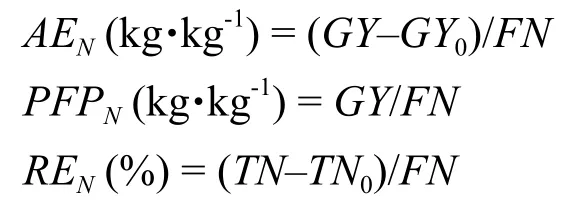
Where,GYandGY0were the grain yield in the plot receiving applied N fertilizer and without receiving N, respectively;TNandTN0represented the total N uptake in aboveground plant at maturity in the plot receiving N and without receiving N, respectively; andFNwas the amount of fertilizer N applied.
Data analysis
Statistix 8 software package (Analytical software,Tallahassee, Florida, USA) was used for analysis of variance. Means of N treatments were compared based on the least significant difference test (LSD) at the 0.05 probability level.
Results
The average maximum temperature was lower in Luzhou City than in Deyang City from transplanting(TR) to heading (HD) by 3.3-3.8℃ in 2016 and 2017(Fig. 1). The difference in the average maximum temperature from HD to maturity (MA) between two locations was inconsistent. The average minimum temperature from TR-HD was lower in Luzhou City than that in Deyang City by 0.3-1.4℃ in 2016-2017,whereas from HD to MA the average minimum temperature was higher in Luzhou City than that in Deyang City by 0.9-3.7℃. The temperatures in Deyang City were similar between 2016 and 2017,whereas 2017 was slightly hotter than 2016 in Luzhou City.
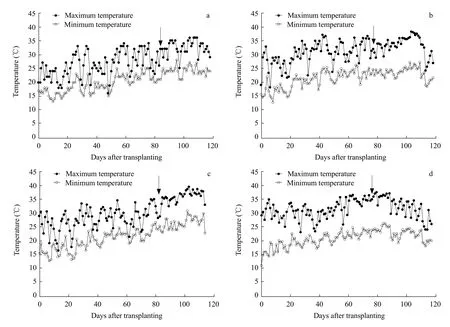
Fig. 1 Daily maximum and minimum temperatures during rice-growing season in Deyang and Luzhou Cities in 2016
Grain yield of hybrid rice was significantly affected by plant density and N rate, but not by their interaction(Table 1). In Luzhou City, the average grain yield under N-23%and NCKwas approximately 9% and 11% higher than that under N-46%at LD treatment,respectively; whereas at HD treatment there was not significantly difference in grain yield among the three N treatments. The average grain yield of hybrid rice under N-23%was higher than that under N-46%and NCKat HD treatment by 5.4% and 6.4%, respectively.In Deyang City, reducing N rate by 46% resulted in significantly lower grain yield regardless of low plant density or high plant density. Average across two years and two plant densities, grain yield of hybrid rice under N-23%and NCKwas higher than that under N-46%by 8.6% and 8.5%, respectively. N-23%had lower grain yield than that of NCKat LD treatment; whereas there was slightly higher grain yield under N-23%than that under NCKat HD treatment. On the average, hybrid rice produced higher grain yield in Deyang City than in Luzhou City by 22.0% in 2016 and by 44.5% in 2017.
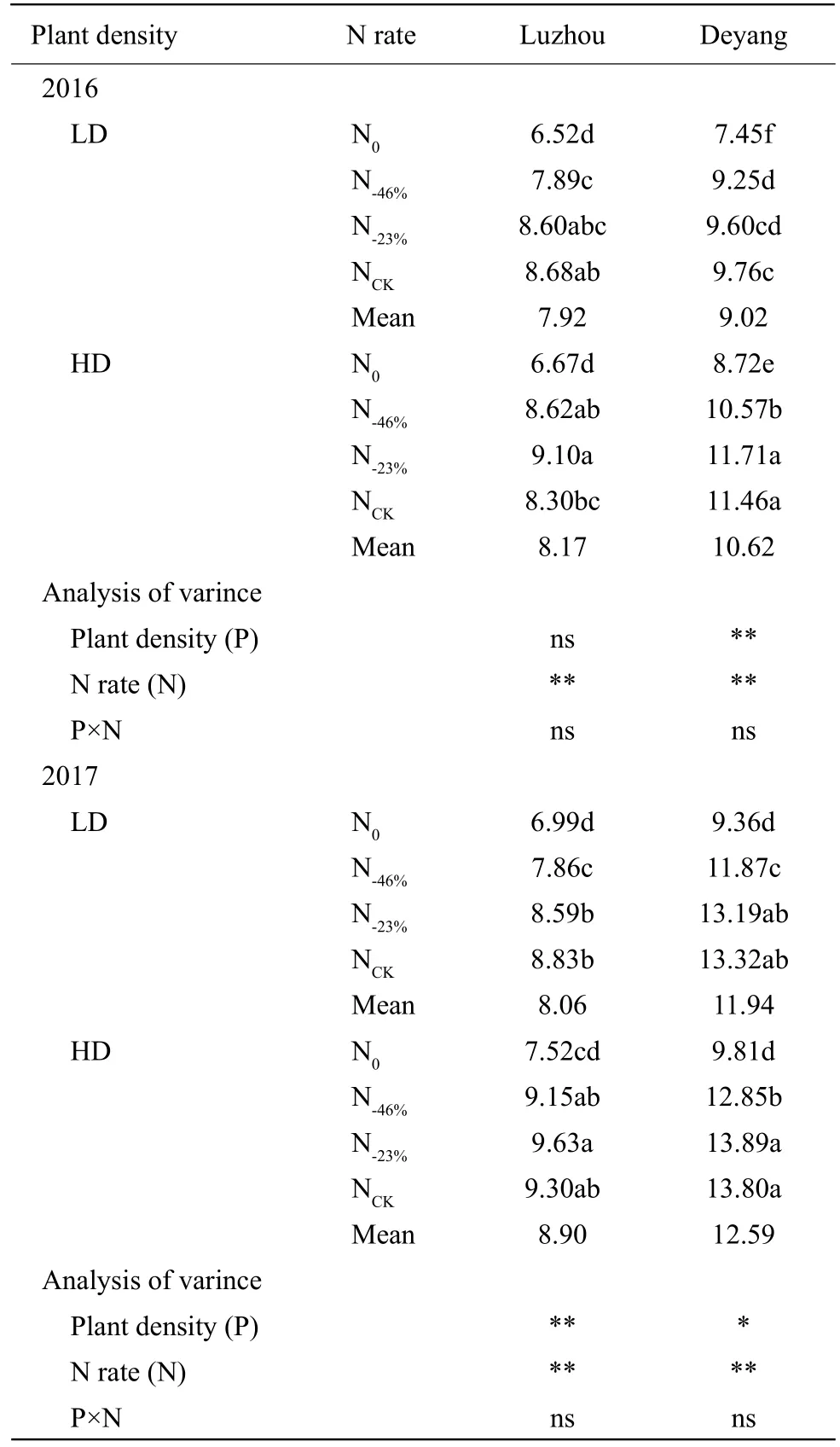
Table 1 Grain yield (t • hm-2) of hybrid rice grown under two plant densities (low plant density, LD; high plant density,HD) and four N treatments in 2016 and 2017
Yield components of hybrid rice is shown in Table 2.In Luzhou City, panicles per square meter increased with increasing N rate regardless of the two plant densities, and there was not significant effect of N rate on spikelets per panicle. Consequently, spikelet number per square meter under N-23%and NCKwere 15%-16% and 15%-18% more than that under N-46%,respectively. Grain filling and grain weight under N-46%was higher than those under N-23%and NCK. In Deyang City, panicles per square meter under N-23%and NCKwere higher than that under N-46%by 2%-7% and 3%-19%, respectively. The difference in spikelets per panicle among the three treatments receiving applied N was relatively small or inconsistent. As a result, the sink size (spikelets per square meter) under N-23%and NCKwere more than that under N-46%by 9%-12% and 11%-16%, respectively. There were not significantly difference in grain filling and grain weight among the four N treatments. N rate was responsible for a 18%-38% increase in sink size at LD and a 25%-41% increase at HD over two locations and two years. On the average, hybrid rice had more panicles per square meter, spikelets per square meter, grain filling and grain weight at Deyang City than those at Luzhou City by 23%, 20%, 14% and 4%, respectively; while there was 2% less in spikelets per panicle at Deyang City than that at Luzhou City.
Dry matter weight and harvest index at maturity of hybrid rice are shown in Table 3. There was significant effect of N rate on dry matter weight at maturity of hybrid rice except at LD treatment in Deyang City in 2016. Dry matter weight of hybrid rice increased with increasing N rates. On the average, the treatments receiving applied N had higher dry matter weight than without N treatment (N0) by 14%-31% at LD and by 24%-35% at HD. On the average, N-23%and NCKhad 7%-10% and 8%-10% higher dry matter weight than that of N-46%, respectively. The N-23%had slightly lower in dry matter weight than that of NCKby 5% at LD treatment and by 2% at HD treatment; however, which had higher harvest index than that of NCKby 1% at LD treatment and by 5% at HD treatment; on the average,hybrid rice produced higher dry matter weight and harvest index at Deyang City than those at Luzhou City by 16.3% and 12.7%, respectively.
There were significant effects of N rate on the total N uptake and the N0consistently recorded the lowest total N uptake at maturity among the four N treatments regardless of the two planting densities(Table 4). On the average, the total N uptake was higher for the treatments receiving fertilizer N than for the treatment without fertilizer N by 48%in Luzhou City and by 44% in Deyang City. For LD treatment, the mean total N uptake across two years under NCKwas higher than that under N-46%by 25% in Luzhou City and by 19% in Deyang City.The difference in mean total N uptake between NCKand N23%was relatively small. For HD treatment, the mean total N uptake across two years under NCKwas about 25% and 5% higher than that under N-46%and N-23%in Luzhou City, respectively; which were about 25% and 6% higher than those of N-46%and N-23%in Deyang City, respectively. The mean total N uptake across two years under HD treatment was higher than that under LD treatment by 5% in Luzhou City and by 16% in Deyang City.
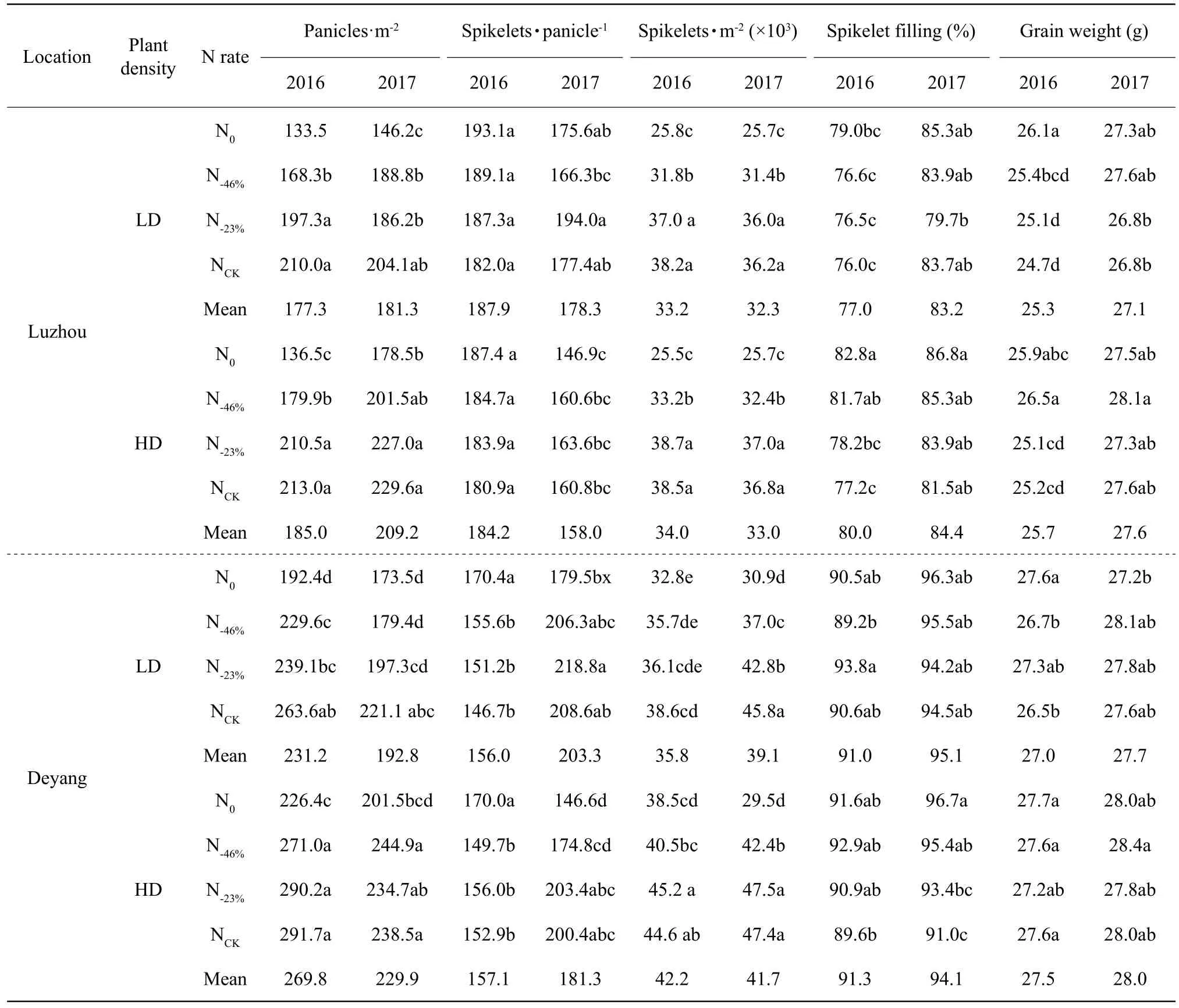
Table 2 Yield components of hybrid rice grown under two plant densities (LD and HD) and four N treatments in 2016 and 2017

Table 3 Dry matter weight and harvest index of hybrid rice grown under two plant densities (LD and HD) and four N treatments in 2016 and 2017
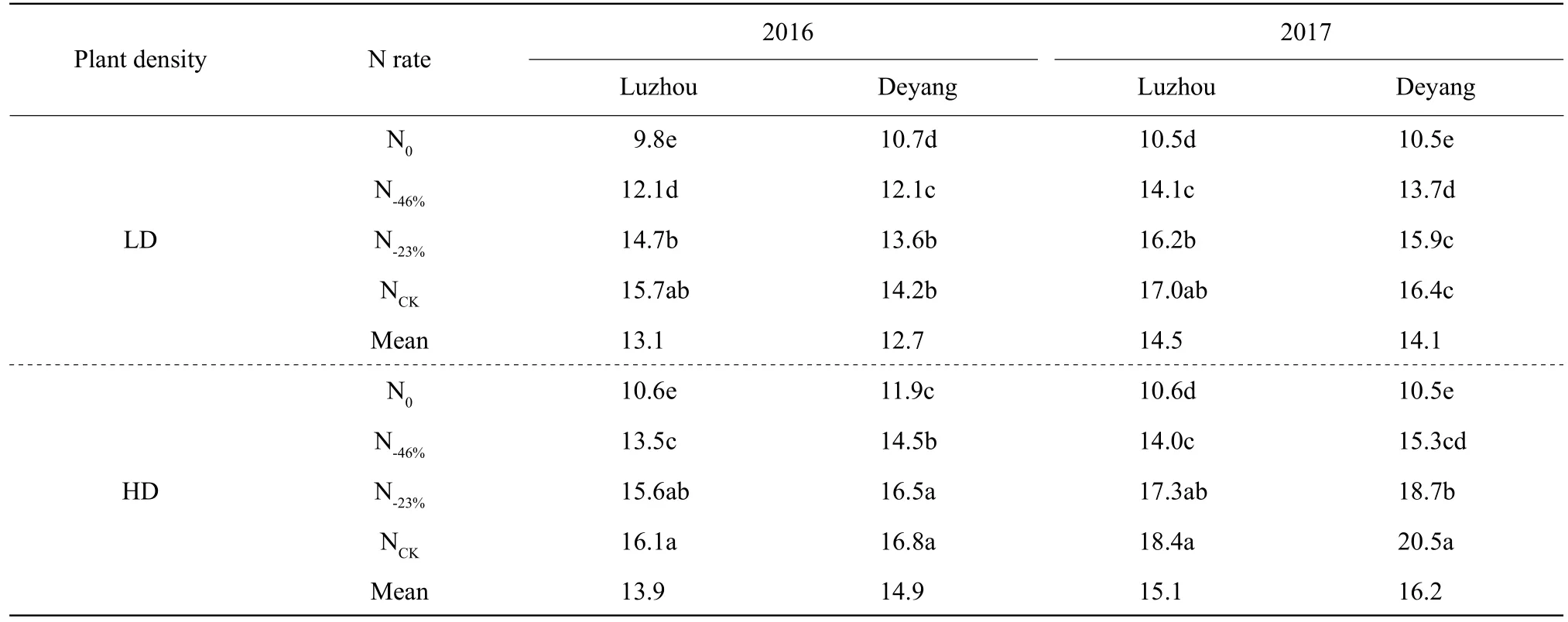
Table 4 The total N uptake (g • m-2) of hybrid rice grown under two plant densities (LD and HD) and four N treatments in 2016 and 2017
Agronomic efficiency of applied N (AEN), partial factor productivity of applied N (PFPN) and recovery efficiency of applied N (REN) of hybrid rice is shown in Table 5. In Luzhou City, there was not significantly difference in AENamong N-46%, N-23%and NCKat LD treatment, whereas at HD treatment there was significantly difference in AENamong N-46%, N-23%and NCK.
The mean AENacross two years under NCKwas less than that under N-46%and N-23%by 9% and 21% at LD treatment, respectively; which was 46% and 42% less than N-46%and N-23%at HD treatment, respectively. In Deyang City, there was significant effect of N rate on AEN(except at LD in 2017) and NCKtreatment recorded the lowest AENamong the three treatments receiving applied N regardless of the two plant densities. The difference in AENbetween N-46%and N-23%was relatively small or inconsistent. There was significant effect of N rate on PFPNin 2016 and 2017,and which decreased with increasing N rates. On the average, the percentages of PFPNunder N-46%and N-23%were 74% and 31% higher than that under NCK,respectively. Mean RENacross two years under NCKwas less than that under N-23%by 10% in Luzhou City and by 13% in Deyang City at LD treatment; however,which was about 12% higher than N-46%in Luzhou City and Deyang City. On the average, RENunder NCKwas less than that under N-23%by 13% in Luzhou City and by 10% in Deyang City at HD treatment. There was not significantly difference in RENbetween NCKand N-46%at HD treatment.
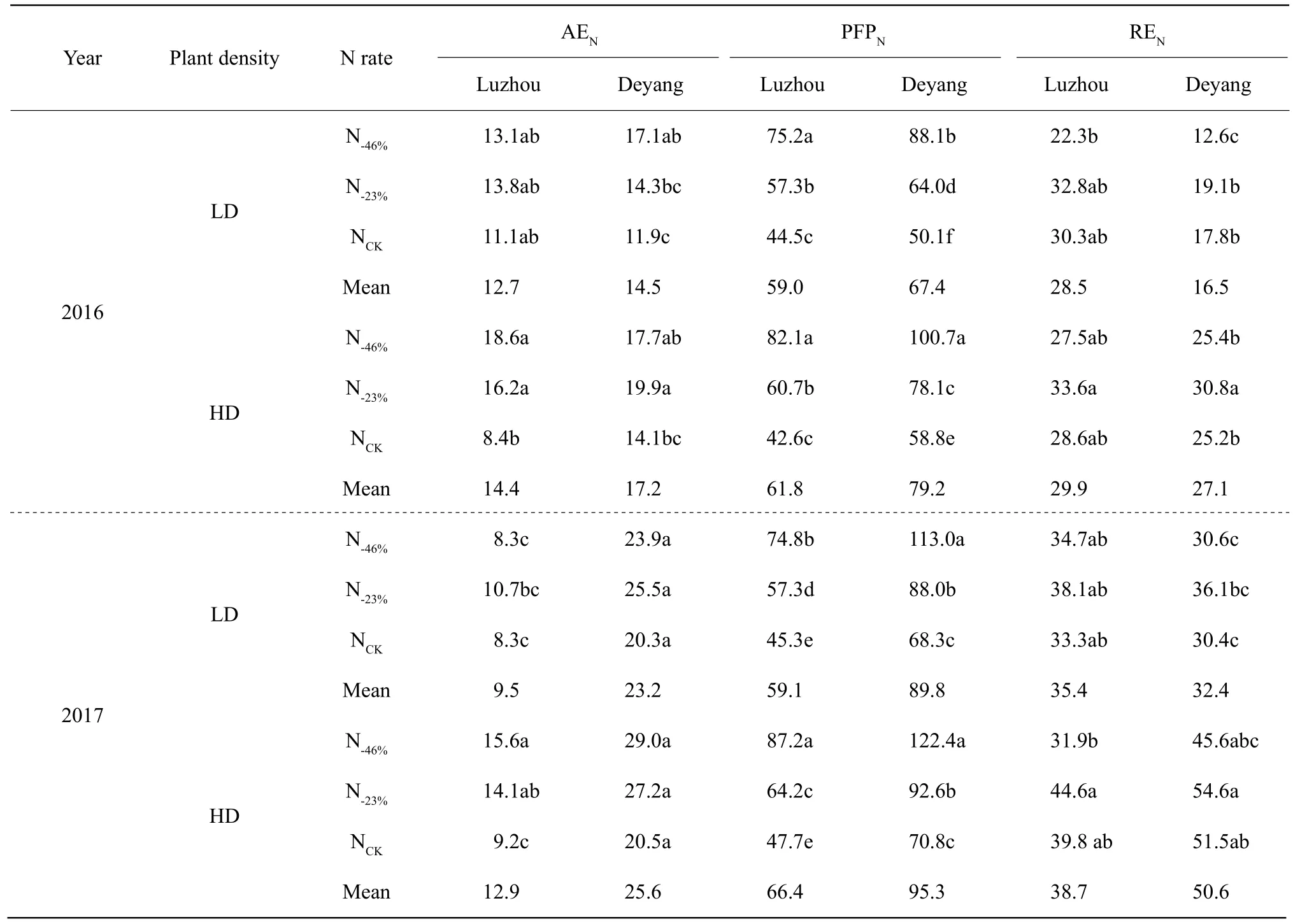
Table 5 Agronomic efficiency of applied N (AEN, kg • kg-1), partial factor productivity of applied N (PFPN, kg • kg-1) and recovery efficiency of applied N (REN, %) of hybrid rice grown under two plant densities (LD and HD) and four N treatments in 2016 and 2017
Discussion
Grain yield of hybrid rice in response to plant density and nitrogen rate
The results showed that the average grain yield in Luzhou City MYS and Deyang City HYS were 8.26 and 11.04 t • hm-2, respectively. The effect of plant density and N rate on grain yield of hybrid rice varied with site (yield level). In Luzhou City, a 46%reduction in N rate resulted in significantly lower grain yield at LD (26 cm×30 cm) treatment, whereas at HD(26 cm×20 cm) treatment, there was not significantly grain yield loss, when N rate was reduced by 46%.In Deyang City, a 46% reduction in N rate led to significantly lower grain yield regardless of LD and HD treatments. These results indicated that the lower grain yield caused by excessively reduction in N rate(a 46% reduction in N rate) could be compensated for by increasing plant density in MYS; however,the negative effect of excessively reduction in N rate on grain yield could not be offset by the increasing plant density in HYS. This finding was not fully in agreement with that reported by Huanget al. (2017)who stated that increased hill density could reduce N rate input without sacrificing grain yield in doublecropping rice. One possible reason for the difference between the two studies was that grain yield level in the two studies was different. The average grain yield of treatments receiving applied fertilizer N was 8.7 and 11.8 t • hm-2in MYS and HYS, respectively; while grain yield of the study of Huang's study was less than 8.0 t • hm-2in double-cropped rice (Huanget al., 2017).In the present study, a 23% reduction in N rate resulted in lower grain yield than NCKat LD treatment in Deyang City, whereas at HD treatment there was slightly higher grain yield under N-23%(a 23% reduction in N rate) than that under NCK. These findings suggested that increased hill density could compensate for grain yield loss from a moderate reduction in N rate (a 23%reduction in N rate) in HYS.
It is well known that grain yield is determined by spikelet number per unit land area (sink size), grain filling and grain weight. For LD treatment, the low grain yield observed for N-46%in Luzhou City and Deyang City was attributed to small sink size, which resulted from low panicle number per unit land area.This finding was fully in agreement with previous studies which reported that sink size was the primary determinant of grain yield (Yinget al., 1998; Zhanget al., 2009; Xuet al., 2014; Jianget al., 2016). For HD treatment, the average sink size under N-46%was significantly lower than that under NCKin Luzhou City, though the average grain yield under N-46%was slightly higher than that under NCK. The difference in grain filling and grain weight were attributed to the yield gap between them. In other words, higher grain filling and grain weight could compensate for the negative effect of lower sink size, which caused by the reducing N input, on grain yield in mediumyielding site. In Deyang City, a 46% reduction in N rate combined with high plant density (HD) caused a large reduction in sink size, which could not be offset by the increase in grain filling and grain weight that result in significantly reduction in grain yield. For HD treatment, when the comparison between N-23%and NCKwas made in Deyang City, the difference in sink size and grain filling were attributed to the yield gap between them. More interesting, N-23%had a larger sink size than NCK; though N-23%consistently had higher grain filling than NCK. It was probable that low harvest index under NCKcompared with that under N-23%reducing the grain filling; because of the dry matter weight under NCKwas consistently higher than that under N-23%.
In another approach, grain yield was determined by biomass production and harvest index. For LD treatment, low grain yield observed for N-46%in Luzhou City and Deyang City were associated with the low dry matter weight, because the difference in harvest index between N-46%and other two treatments receiving applied N was relatively small. This result agreemented with previous reports which stated that further increase in harvest index under favorable conditions was difficult to achieve (Lazaet al., 2003)and improvement in grain yield might be driven from the increased biomass production (Penget al., 2009;Jianget al., 2016). For HD treatment, a higher harvest index observed for N-23%in Luzhou City and Deyang City could compensate for the negative effect of lower dry matter weight, which caused by the reducing N input, on grain yield. Thus, the average grain yield under N-23%was higher than that under NCK.
N uptake and use efficiency of hybrid rice in response to plant density and nitrogen rate
Increasing plant density could enhance rice plants N uptake (Wanget al., 2003), and reducing N application rate was believed to improve N use efficiency in rice field (Penget al., 2010; Zhu and Jin, 2013; Denget al., 2014). AEN, PFPN and REN were usually used to measure N cycling efficiency in ago-ecosystems(Xuet al., 2010; Deligioset al., 2017). In the present study, HD treatment had 10%, 17%, 10% and 30%higher total N uptake, AEN, PFPNand RENthan LD treatment, respectively; and AENand PFPNincreased with decreasing N rates. For HD treatment, a 46%reduction in N rate resulted in significantly higher AENand PFPN in Luzhou City, and the grain yield under N-46%was equally to that under N-23%and NCK. The difference in REN between N-46%and NCKwas relatively small. This result suggested that an appropriated reduction in N rate and an increase in plant density could have few or no effect on grain yield, but could increase N use efficiency in mediumyielding site. Similarly, excessively reduction in N rate(a 46% reduction in N rate) could lead to significantly high AENand PFPNat HD treatment in Deyang City,though which resulted in significantly lower grain yield and the total N uptake. Moderate reduction in N rate (a 23% reduction in N rate) recorded the highest grain yield and REN at HD treatment in Deyang City, and which did not result in significantly lower in AEN. In comparison to the combination of NCKwith HD treatment, the combination of N-23%with HD treatment had 36%, 31% and 11% higher in AEN,PFPNand REN, respectively. The results indicated that high plant density with moderate N rate could be a good technique for improving high yield and N use efficiency in HYS in China.
About a 30% difference in grain yield existed between Luzhou City and Deyang City. The high grain yield at Deyang City was attributed to high spikelets per square meter, percentage of grain filling, grain weight, dry matter weight and harvest index. The high spikelets per square meter at Deyang City resulted from high panicle number per unit land area, because the spikelet number per panicle was lower at Deyang City than at Luzhou City. More interesting, although sink size of hybrid rice was larger at Deyang City than at Luzhou City, the grain filling of hybrid rice was consistently higher at Deyang City than at Luzhou City. One possible reason was that high minimum temperature during grain filling at Luzhou City compared with Deyang City reduced the grain filling.This finding was in agreement with previous reports by Seshu and Cady (1984) and Kobataet al. (2006),who stated that high night temperatures reduced assimilate supply to the grains during grain filling.
Conclusions
In the present study, the response of grain yield of hybrid rice to N rate varied with yield level and plant density. For MYS, excessively reduction in N rate (a 46% reduction in N supply) could result in less panicle number per unit land area and sink size(spikelet number per unit land area), and lower dry matter weight, and consequently lower grain yield,but these negative effects could be compensated for by increasing plant density. For HYS, moderate reduction in N rate (a 23% reduction in N supply)resulted in lower grain yield, which was attributed to the less panicle number per unit land area and lower dry matter weight, but increasing plant density could offset these negative effects caused by reducing N rate.Meanwhile, NUE decreased with increasing N rate. In order to achieve synchronization between high yield and high N use efficiency, the total amount of N supply should be reduced. In the present study, considering the demands for high grain yield and high NUE, a 46%reduction in N rate with high plant density in MYS and a 23% reduction in N rate with high plant density in HYS could achieve both goals. Therefore, about 40% and 20% reduction in N rate with dense planting in MYS or HYS, respectively was a feasible strategy to achieve synchronization both high grain yield and N use efficiency.
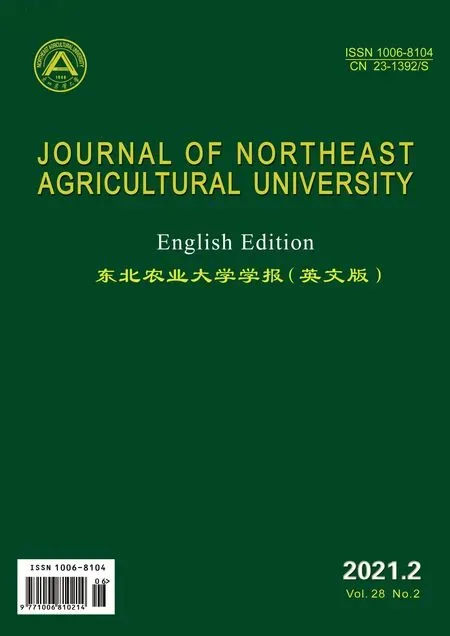 Journal of Northeast Agricultural University(English Edition)2021年2期
Journal of Northeast Agricultural University(English Edition)2021年2期
- Journal of Northeast Agricultural University(English Edition)的其它文章
- Identification of QTLs Associated with Resistance to Pseudomonas syringae pv. Glycinea in Soybean (Glycine max (L.) Merr)
- Development of an Artificial Diet for Effective Oral Delivery of dsRNA to Soybean Pod Borer, Leguminivora glycinivorella (Lepidoptera: Tortricidae)
- Index Design and Comprehensive Evaluation of Germplasm Resources of Fruits Based on Mathematical Model of AHP and FCE: Sterculia nobilis Smith as a Case
- Effects of Interaction of Soil Moisture and Organic Matter on Powdery Mildew Disease and Growth of Heracleum moellendorffii Hance
- Comparative Analysis of Bacillus thuringiensis Vip3Aa57 and Vip3Aa62 Insecticidal Activities
- Comprehensive Evaluation of Processing Quality of Tibetan Native Hulless Barley Variety by Factor Analysis
